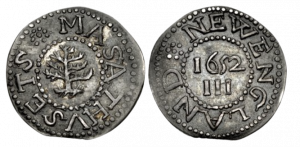Massachusetts Coins: The First Silver Coins Struck on American Soil
Posted onThirty two years after the Mayflower landed on Cape Cod with 101 adventurous souls, Bostonians began minting silver coins. At this time the American colonies were, of course, ruled by England. And the colonial governments were run according to the charters granted by England’s king. A few of the charters permitted the colonial governments to mint coins, but most did not.
Massachusetts Bay was the first English colony to challenge this prohibition when the Massachusetts General Court in 1652 ordered that silver three pence, six pence and shilling could be struck in the English Americas.
The Massachusetts Bay government was simply trying to fill a huge need for standardized currency. Before this, the New England settlers were using “wampum” as a medium of exchange. Wampum was created from shells ground to the size of a kernel of corn. A hole was drilled through each piece so wampum could be hung on a strip of leather for convenience.
The early mint, located in Boston, was run by Mintmaster John Hull and his assistant Robert Saunderson. The first Massachusetts silver coin designs were simplistic with one side punched with a small NE for New England and the other side punched with the coin’s denomination in Roman numerals. For example, a shilling would show XII.
Surprisingly, the original legislation authorizing these coins required them to be square, not round. However, another subsequent law changed the shape to be round. Soon after, the Boston minters began creating additional varieties known today as the Willow, Oak and Pine Tree series. The Willow Tree silver coins were struck from 1653 until 1660, the Oak Trees from 1660 to 1667 and then the Pine Trees from 1667 to 1682.
These historic silver pieces were struck on handmade dies that were often individually distinct. That created a great number of die varieties for today’s advanced collector seeking levels of rarity. Nonetheless, all of these early colonial coins are scarce to rare today. The Pine Tree coinage survives in larger numbers than the Willow or Oak issues, making them the easiest to source and locate of the group.
Collectors today may find some surviving Massachusetts silver pieces to be slightly bent. At that time, due to superstitions, many of these silver pieces were bent and then straightened back out. Some people believed that bending the coin would ward off evil spirits. Many of these early Massachusetts silver coins were also holed and worn as a pendant for the same reasons.
A group of these 128 rare Massachusetts Colonial coins were sold for $2.9 million in a 2022. The coins were from the collection of numismatic researcher Christopher J. Salmon The top lot was a 1652 Willow Tree Sixpence graded NGC AU 55 that realized $312,000.
If you are intrigued by this story, reach out to a Blanchard portfolio manager today. Some of the early Massachusetts silver pieces are scarce and affordable while others are ultra-rare and costly, meaning a coin from unique and exciting era in early American history could be within your grasp, no matter the range of your investment level.
Want to read more? Subscribe to the Blanchard Newsletter and get our tales from the vault, our favorite stories from around the world and the latest tangible assets news delivered to your inbox weekly.







